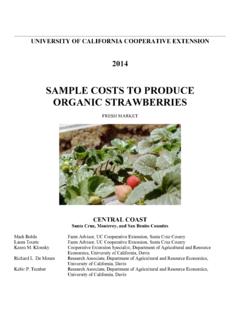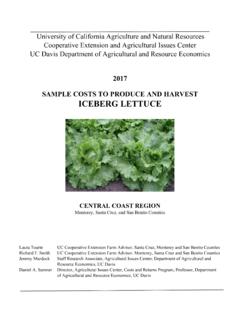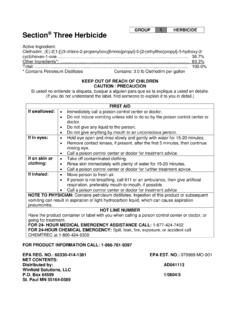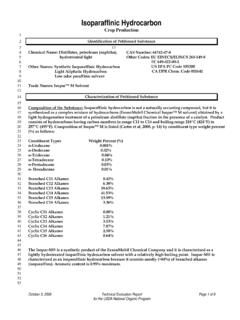Transcription of SAMPLE COST TO ESTABLISH AND PRODUCE
1 COOPERATIVE EXTENSIONSAMPLE COST TO ESTABLISH AND PRODUCECARROTSIMPERIAL COUNTY 2000 Prepared by:Keith S. MayberryFarm Advisor, Cooperative Extension, Imperial CountyFor an explanation of calculations used for the study refer to the attached General Assumptions or call the author, Keith S. Mayberry , at theImperial County Cooperative Extension office, (619)352-9474 or e-mail at University of california Cooperative Extension in compliance with the Civil Rights Act of 1964. Title IX of the Education Amendments of1972, and the Rehabilitation Act of 1973 does not discriminate on the basis of race, creed, religion, color, national origins, or mental or physicalhandicaps in any of its programs or activities, or with respect to any of its employment practices or procedures. The University of california doesnot discriminate on the basis of age, ancestry, sexual orientation, marital status, citizenship, medical condition (as defined in section 12926 of theCalifornia Government Code) or because the individuals are disabled or Vietnam era veterans.
2 Inquiries regarding this policy may be directed tothe Personnel Studies and Affirmative Action Manager, Agriculture and Natural Resources, 2120 University Avenue, University of california ,Berkeley, california 94720, (510) of california and the United States Department of Agriculture wish to thank growers, pest control advisors, seed companies, transplant producers, contractharvesters, fertilizer dealers, and equipment companies for providing us with the data necessaryto compile this circular. Without them we could not have achieved the accuracy needed forevaluating the cost of production for the dynamic and important vegetable industry in information presented herein allows one to get a "ballpark" idea of vegetable productioncosts and practices in the Imperial County. They do not reflect the exact values or practices ofany grower or shipper, but are rather an amalgamation of countywide prevailing costs andpractices.
3 Exact costs incurred by individual growers depend upon many variables such asweather, land rent, seed, choice of agrichemicals, location, etc. No exact comparison withindividual grower practice is possible or intended. The budgets do reflect, however, theprevailing industry trends within the usually includes secretarial and office expenses, supplies, donations, utilities,transportation, accountants, insurance, safety training, permits, etc. In most of the cropguidelines contained in this circular we used 13% of the total of land preparation, growing costsand land rent to estimate overhead. For crops that require additional labor or extra operations( leaf lettuce) we used 17% overhead to account for the additional all of the inputs used to figure production costs are impossible to document in a singlepage, we have included extra expense in man-hours or overhead to account for such items as pipesetting, motor grader, water truck, shovel work, etc.
4 Whenever possible we have given the costsof these operations per included in these production costs are expenses resulting from management fees, loans,supervision, or return on investments. The crop budgets also do not contain expensesencumbered for cleanup discing, road and ditch maintenance, perimeter weed control. If all theabove items were taken into account, the budget may need to be increased by 7-15%.Keith S. Mayberry Refugio A. Gonzalez(Principal researcher and editor)County DirectorFarm AdvisorVegetable CropsTom TuriniKhaled M. BaliEric T. NatwickFarm AdvisorFarm AdvisorFarm AdvisorPlant PathologyIrrigation/Water Science EntomologyJose L. AguiarMark D. StutesFarm StaffVegetable CropsCoachella ValleyAugust 20002000-2001 VEGETABLE CROPS PREVAILING RATES IMPERIAL COUNTY_____ _____ HEAVY TRACTOR WORK & LAND PREPARATIONOPERATION $ , 2nd , 3rd gear.
5 15" .. chisel .. Ox .. borders .. cross checks (taps) .. border .. , stubble .. , regular .. 40" beds .. , (acre) .. (scraper) borders .. , CULTIVATING & LIGHTTRACTOR WORK $/HRPower mulch mulch with herbicide .. 40" beds .. plant 40" beds .. 4-row 40" beds .. 40" beds .. and furrow 4-rows 40" out 40-42" beds .. 40" 40" beds with/herbicides .. fertilizer and furrow out 40" dry and furrow out 40" beds .. dry fertilizer >300lb/a .. dry fertilizer <300lb/a .. spray spray herbicide .. RATES BY THE HOUR $/HRMotor grader .. truck .. tractor .. ends of setting (2 men) .. $ acre-foot of irrigate *Note Cultural rates for specific crop operationslisted on crop Cooperative Extension-Imperial County Vegetable Crops Guidelines Aug. 2000 CARROT CULTURE 2000-2001 Annual acreage, yield, and value of fresh market carrotsImperial County, CA (1995-1999)YearAcresYield/Acre*Value/Acr e19996,798834$7,68119986,692796$6,253199 76,560777$5,35919966,588708$4,036199514, 959820$7,109 Annual acreage, yield, and value of processing & other carrotsImperial County, CA (1995-1999)YearAcresYield/Acre*Value/Acr e199910, $2,45219989, $2,30119979, $1,05819969, $2,892199514,959NA$7,109 Annual acreage, yield, and value of fresh market carrotsTotal units, Imperial County, CA (1995-1999)Year TotalAcresYield/Acre*Value/Acre199916,99 5834$4,544199816,416796$3,912199716,0147 77$3,903199616,469708$3,350199514,959820 $7,109*50 pound master poly sacks containing cello packs basis.
6 Many sold : Imperial County Agricultural Commissioner's Reports 1995-1999UC Cooperative Extension-Imperial County Vegetable Crops Guidelines Aug. 2000 PLANTING-HARVESTING DATES Early maturing carrots are planted in early September. Later maturing carrots are planted in October and early November. Most of the carrots grownlocally are shipped to Bakersfield for packing. The majority of the harvest starts in February andruns through mid-May. Carrots could be harvested December to early June if desired. Florida,Texas, Bakersfield and Arizona provide the most market competition during our shipping Caro Pak; Asgrow; Apache Sunseeds; Navajo Sunseeds; Indiana Bejo; and HM 02 Harris Moran. Varieties used for shortcuts or cut and peel include: Primecut 59 Sunseeds;Tripleplay 58 Sunseeds; and Snackpack INFORMATION Carrots may be planted 6 seed lines per 40 inch bed. Threerows are placed on each bed shoulder.
7 Rows are usually 1 inches apart. However, there aremany variations of the number of lines, spacing between lines and bed width depending upon theshippers needs and ultimate product use. A ball park value is 38-42 plants per foot of bed. Planting fewer seed produces large carrots for the shredder processing use, planting largeamounts of seed is necessary for smaller diameter carrots for short cut use. Natural and pelleted seed are both used. For natural seed, most growers use converted PlanetJr. planters utilizing a random flow distribution of seed drop. Stanhay planters with split shoeshave been used for precision planting. Seed is placed in a shallow groove and not covered. Enough sandy soil will cave into thegroove during sprinkler irrigation to place the seed at the proper depth. Carrots may be sown at a rate of 1,000,000 live seed per acre. Germination is often 80-90percent and seed counts may be 175,000 to 400,000 seed per pound.
8 The seeding rate per acre iscalculated accordingly. Again this seeding rate is a variable factor and the ultimate control overpopulation should be the decision of the Carrots have been grown on many of the soil types in the low desert. However, best rootdevelopment is obtained with the lighter, sandy-textured soils. Carrots should not be grown onstratified soils. If soils are too heavy (clayey), deformed and hairy roots will result. A deeporange color will not develop if the soil stays too Carrots are sprinkler irrigated for stand establishment. Carrots germinateslowly, therefore, the beds must be kept moist to prevent crusting. They may take as long as 10days to germinate in cool weather. Sprinklers also reduce salinity, which is important, since carrots are very sensitive to costs include rent, in-and-out labor, system maintenance and sprinkler operation. After sprinkling, carrots are normally furrow irrigated for the remainder of the season.
9 Thenumber of irrigations may vary with climatic conditions, soil type, ultimate use of the carrot crop,and variety. The number of irrigations may vary from 4 to 6 per season after Cooperative Extension-Imperial County Vegetable Crops Guidelines Aug. 2000 Drip irrigation has not worked well with carrots. Excess water due to over-irrigation orproducing carrots on poorly drained soils tend to increase the incidence of hairy roots. If carrot fields are allowed to become too dry and then irrigated, there may be significantsplitting of roots. Dryness tends to cause the cell walls to harden and lose elasticity. When morewater is applied the carrot core expands while the outer layers do not, resulting in Previous crop history is helpful in determining early-season nitrogen fertilizerrequirements. If the field has some residual nitrogen (N), there is no need to apply more N untilthe seedlings emerge.
10 Carrot roots are vulnerable to forking if too much nitrogen is appliedpreplant. Phosphate is applied before listing at rates of 450 to 500 pounds of 0-45-0 per acre. Preplant fertilizer should be disced into the soil before listing to prevent forking. Sidedress applications of 60 to 80 pounds of actual N are made during the growing season. Commonly used materials are dry ammonium nitrate (34-0-0), liquid ammonium nitrate (20-0-0),and UAN 32 (32-0-0). Shippers may wish to vary nitrogen recommendations to the growerbased upon knowledge of the varietal performance and plant spacing. Nitrogen deficiency in carrots is not readily apparent when viewing a field. Deficient fieldsmight show an irregular pattern in height of the top growth, but the foliage will still be green incolor. Since carrots are often grown on sandy soils, taking petiole analysis on a regular basis willhelp monitor the fertilizer CONTROL Needle nematode (Longidorus africanus) and root knot nematode(Meloidogyne spp.)













